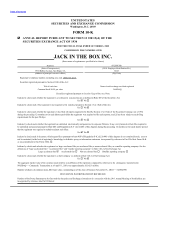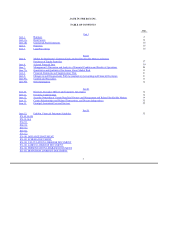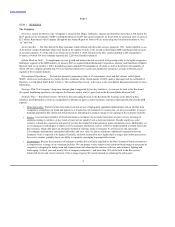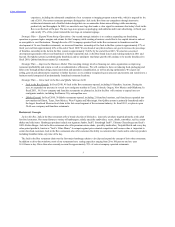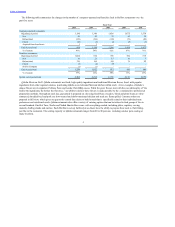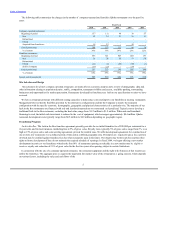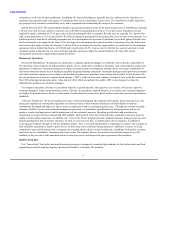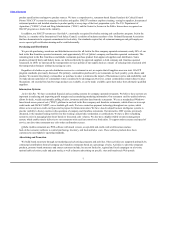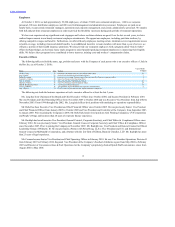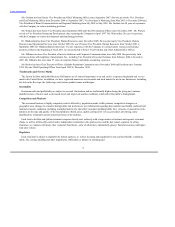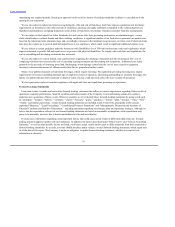Jack In The Box 2010 Annual Report Download - page 7
Download and view the complete annual report
Please find page 7 of the 2010 Jack In The Box annual report below. You can navigate through the pages in the report by either clicking on the pages listed below, or by using the keyword search tool below to find specific information within the annual report.
Table of Contents
restaurant, as well as its location and history. In addition, the land and building are generally leased or subleased to the franchisee at a
negotiated rent, generally equal to the greater of a minimum base rent or a percentage of gross sales. The franchisee is usually required to
pay property taxes, insurance and ancillary costs, and is responsible for maintaining the image of the restaurant.
The current Qdoba franchise agreement generally provides for an initial franchise fee of $30,000 per restaurant,
a 10-year term with a 10-year option to extend at a fee of $5,000, and marketing fees of up to 2% of gross sales. Franchisees are also
required to spend a minimum of 2% of gross sales on local marketing for their restaurants. Royalty rates are typically 5% of gross sales
with certain agreements at 2.5% as noted below. We offer development agreements for the construction of one or more new restaurants over
a defined period of time and in a defined geographic area for a development fee, a portion of which may be credited against franchise fees
due for restaurants to be opened in the future. If the developer does not maintain the required schedule of openings, they may forfeit such
fees and lose their rights to future development. In fiscal 2010, as an incentive to develop target markets, we entered into two development
agreements with an initial franchise fee of $15,000 and a royalty rate of 2.5% of gross sales for the first two years of operation for each
restaurant opened within the first two years of the development agreement, subject to certain limitations. We may offer similar
development agreements in target markets during fiscal 2011.
Restaurants are operated by a company-employed manager or a franchisee who is directly responsible for
the operations of the restaurant, including product quality, service, food safety, cleanliness, inventory, cash control and the conduct and
appearance of employees. Restaurant managers are required to attend extensive management training classes involving a combination of
classroom instruction and on-the-job training in specially designated training restaurants. Restaurant managers and supervisory personnel
train other restaurant employees in accordance with detailed procedures and guidelines using training aids available at each location. We
also use an interactive system of computer-based training (“CBT”), with a touch-screen computer terminal at Jack in the Box restaurants.
The CBT technology incorporates audio, video and text, all of which are updated via satellite. CBT is also designed to reduce the
administrative demands on restaurant managers.
For company operations, division vice presidents supervise regional directors, who supervise area coaches, who in turn supervise
restaurant managers. Under our performance system, division vice presidents, regional directors, area coaches and restaurant managers
are eligible for periodic bonuses based on achievement of goals related to location sales, profit and/or certain other operational performance
standards.
We devote significant resources toward ensuring that all restaurants offer quality food and good service. We
place great emphasis on ensuring that ingredients are delivered timely to the restaurants. Restaurant food production systems are
continuously developed and improved, and we train our employees to deliver consistently good service. Through our network of quality
assurance, facilities services and restaurant management personnel, we standardize specifications for food preparation and service,
employee conduct and appearance, and the maintenance of our restaurant premises. Operating specifications and procedures are
documented in on-line reference manuals and CBT modules. During fiscal 2010, most Jack in the Box restaurants received at least two
quality and food safety inspections. In addition, our “Voice of the Guest” program provides restaurant managers with guest surveys each
period regarding their Jack in the Box experience. In 2010, we received more than 1.2 million guest survey responses, in addition to
receiving guest feedback through our toll-free telephone number. Also, we recently implemented a comprehensive, system-wide program at
Jack in the Box restaurants to improve guest service by delivering a more consistent dining experience. Additional resources are being
committed to more closely measure how restaurants are executing the key drivers of guest satisfaction, including: food quality, accuracy,
hassle free service, friendliness, cleanliness and service times. The regional director, area coach and restaurant manager receive the
feedback so they are able to take immediate action to correct any issues and improve the guest experience in the restaurant.
Our “farm-to-fork” food safety and quality assurance program is designed to maintain high standards for the food products and food
preparation procedures used by company-operated and franchise restaurants. We maintain
6

